The way we work has shifted beyond offices and cubicles. More companies are adopting hybrid working models, where people can blend working from different locations: home, on the go, or in the office. Recent data shows that six in ten people with remote-capable jobs now prefer hybrid arrangements, making flexible work options a must-have for companies looking to build diverse, engaged, and high-performing teams. Plus, over 60 percent of managers say working from home increases motivation—and 59.5 percent agree it increases productivity.
This guide breaks down different types of hybrid work models and shows HR leaders how to implement flexible arrangements that improve employee engagement and business performance. We’ll also review original findings from a 2020 study HiBob conducted during the expansion of hybrid work models as well as additional benefits and challenges discovered in the years since.
What is a hybrid work model?
The hybrid working model is a location-flexible arrangement that allows people to combine on-site and off-site work as they and their employers see fit.
This gives professionals dramatically increased flexibility around their work patterns. A hybrid work arrangement means establishing a different relationship with the office environment, taking a people-focused approach to work requirements, and reconceiving the workplace as an ecosystem of networked workers, rather than one specific location.
Large corporations around the world have made flexible arrangements the norm, including Adobe, Apple, Google, and Meta.
Different types of hybrid working models
Employers offer their people many different kinds of work arrangements: at-will, split weeks, shift work, and week-by-week.

1. The at-will model
This model enables people to choose the work arrangement that works best for them on any given day. It’s particularly useful for those who want to come into the office when they need to meet someone or require a quiet place to work for the day. Companies set up a process of placing a request to work from office (WFO).
2. The split-week model
The second model splits the week between working from home two to three days a week and working on-site two to three days a week. This model was seen among the highest proportion of people in our study. Companies using this model generally split up the week between different departments. For example, the marketing team comes into the office on Mondays and Wednesdays, while customer support comes into the office on Tuesdays and Thursdays. This hybrid model enables managers to stay in touch with their teams and allows for face-to-face group meetings at a regular cadence.
3. Shift work
In the third model, team members work in shifts, alternating between working from home and working morning or evening shifts on site. This is a more difficult model to work with because many people don’t like shift work and find it hard to get in very early in the morning or to work late at night. A hybrid model based on shift work often requires people to set up additional childcare arrangements on top of the ones they already have.
4. Week-by-week
Finally, the fourth model sees people alternating between working from home and on-site on a weekly basis. This variation is used to allow large teams to use office space together at the same time and meet up for reviews, deadlines, and updates.
HiBob’s hybrid work study
Following the lifting of COVID-19 lockdowns worldwide, a wide range of hybrid arrangements emerged, granting people flexibility that was seldom offered before. During this time, we set out to understand the value of hybrid work and its impact on people’s general feelings toward their places of work, productivity, and wellbeing. To do this, we surveyed 1,000 UK-based full-time workers aged 18+ across all industries who had continued working full-time throughout the first COVID-19 lockdown. This survey followed a study we conducted in the United States in May of 2020, which explored attitudes and opinions about remote work and productivity.
Our goal was to understand the value of hybrid work for people and their employers. We asked professionals to tell us about their feelings about HR, changes in their productivity, and any impact on their mental health and wellbeing. While COVID-19 and lockdowns may feel like a distant past, the influence of that period on how we work today is still very present. Hybrid work continues to shape expectations around flexibility, autonomy, and support.
Who was working from home?
Of the 1,000 survey respondents, 21 percent were working exclusively from home, 42 percent were working according to a hybrid framework, and 37 percent were working on-site. A total of 63 percent of people working full-time were working from home at least part of the time, which showed a significant change in the world of work compared to how people worked before the pandemic.
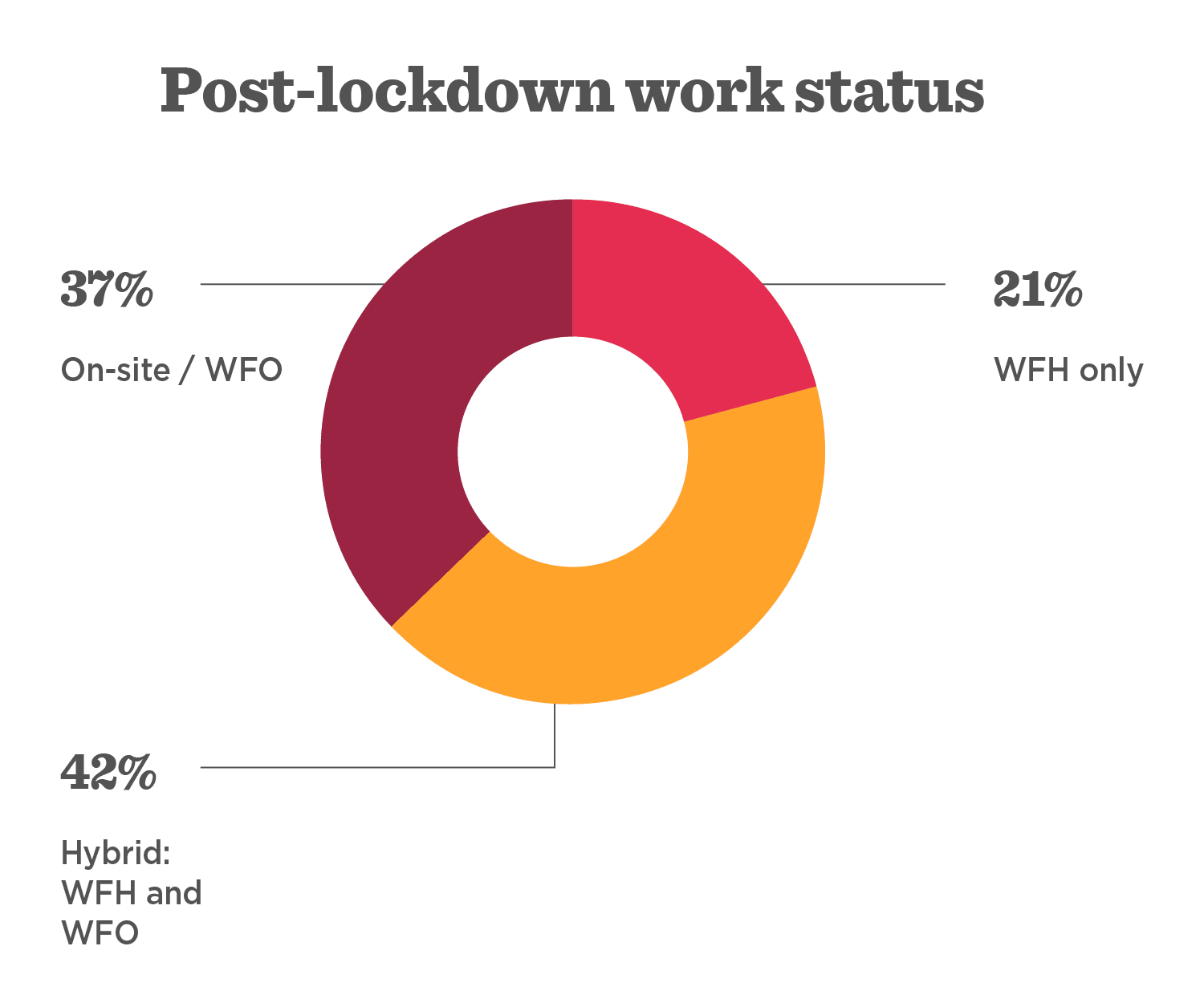
Benefits of hybrid working models found in our COVID-19 hybrid work study
The wide adoption of hybrid working models after 2020 wasn’t merely down to chance. They were driven by the considerable benefits they offer to people, companies, and the environment. They promised:
- Increased flexibility and productivity, with less time spent commuting
- The versatility to use office space for collaborative projects and to build employee relations
- Smaller office footprints, reducing company overheads
- An expanded talent pool, granting access to a global workforce
Hybrid working also improves worker satisfaction rates, which is important for remaining competitive in today’s recruitment market.
Increased productivity
Whether your people are writing code, on a call solving a customer’s inquiry, or trying to conduct a team meeting, their time is valuable, and they (usually) want to perform well. Some feel more productive when working from home, while others see increased productivity when working on-site. Productivity at home can be affected by many factors, such as available workspace and whether there are children or other distractions that hinder their ability to get work done.
When asked about their general productivity while working from home, we found that 48 percent of people felt productive when working from home, while 52 percent did not feel the same. We found an interesting uplift in feelings of productivity among those working from home who were able to go into the office at will—the most flexible of all of the work arrangements. These professionals choose to work on site perhaps for a change of scenery, to collaborate with their team face-to-face, or to avoid situations that aren’t conducive to deep work (think daytime construction). This at-will hybrid arrangement has helped them to be productive.
Like people who were able to work hybrid, team members working exclusively from home also reported high levels of productivity, with 66 percent reporting being productive or very productive.
Focusing on those working on site only, the data showed that 68 percent of them did not feel productive working from home during the period that they were forced to. This may be due to the nature of their work—and why they returned to working on site when lockdowns were lifted.
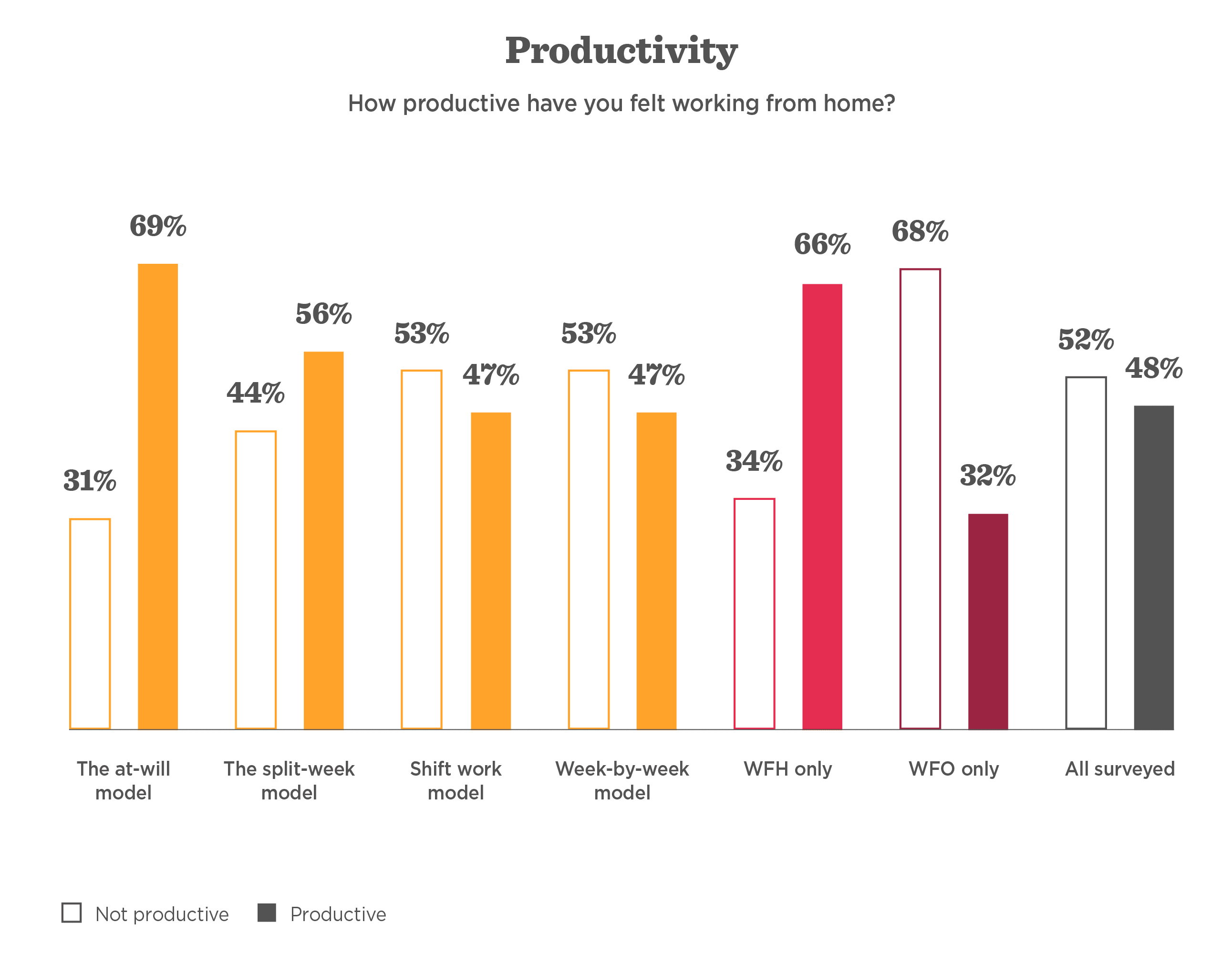
Higher job satisfaction
The nature of our work changed after the pandemic, and so did job satisfaction. We found that while 53 percent of survey respondents overall reported being satisfied with their jobs, 47 percent of team members said they didn’t feel satisfied during the height of the pandemic. These results revealed that there was a lot of work to be done to improve job satisfaction, and according to what we learned about hybrid work satisfaction, more flexible arrangements could be the solution.
People who can work in a hybrid model are more satisfied with their jobs than those working at home exclusively or on site exclusively. Sixty-five percent of the team members who could work from home and on site at will were satisfied with their jobs, while only 53 percent of those working on site exclusively and only 57 percent of those working from home exclusively were satisfied with their jobs.
HiBob’s conclusion: This high level of satisfaction felt by people with the at-will policy can be attributed to the sense of freedom that they have regarding where they work. Workplace flexibility is positively associated with increased productivity and job satisfaction.
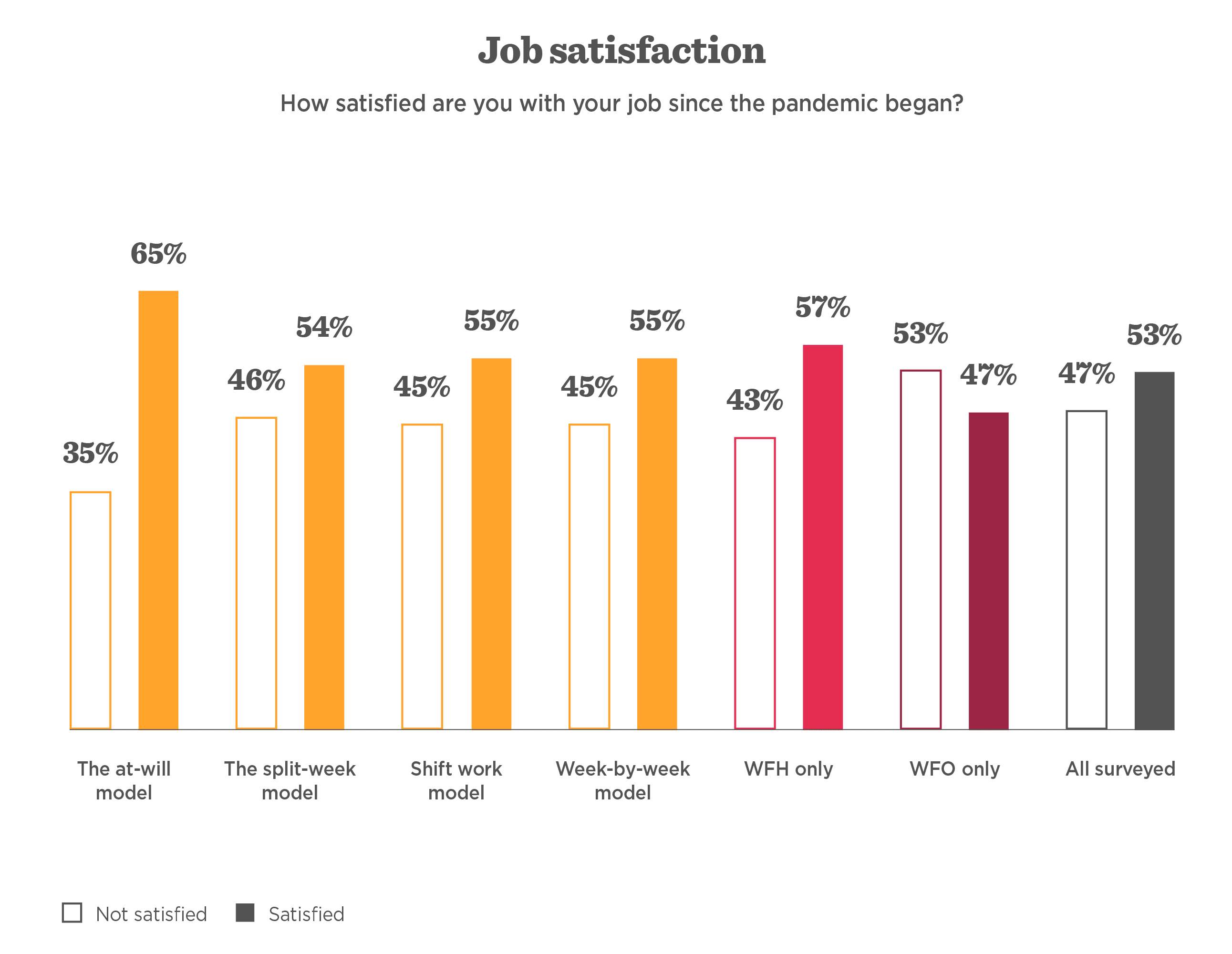
Improved mental health and wellbeing
There’s no doubt that COVID-19 had a deep impact on mental health worldwide. Isolation, health concerns, and economic uncertainty caused a staggering 27 percent drop in self-reported mental wellness in the workplace across all segments and populations.
When asked to reflect on their wellbeing during the pandemic, only 48 percent of those surveyed said they were doing well—significantly lower than pre-pandemic levels. This dip in wellness highlighted the need for more supportive, flexible work environments moving forward.
People look to HR to provide them with a safe environment and to ensure that they are comfortable and well taken care of at work. Offering flexible workplace solutions is an example of how HR can help team members remain productive and relieve uncertainty and anxiety. We found that 60 percent of team members splitting their week and 54 percent of those working from home and on site at will reported that they were doing well. However, only 50 percent of people working exclusively at home and 43 percent of people working on site said that they were doing well.
Hybrid work models have had a positive impact on wellbeing and mental health at work and HR teams leading this initiative have succeeded in increasing the general wellbeing of their teams.
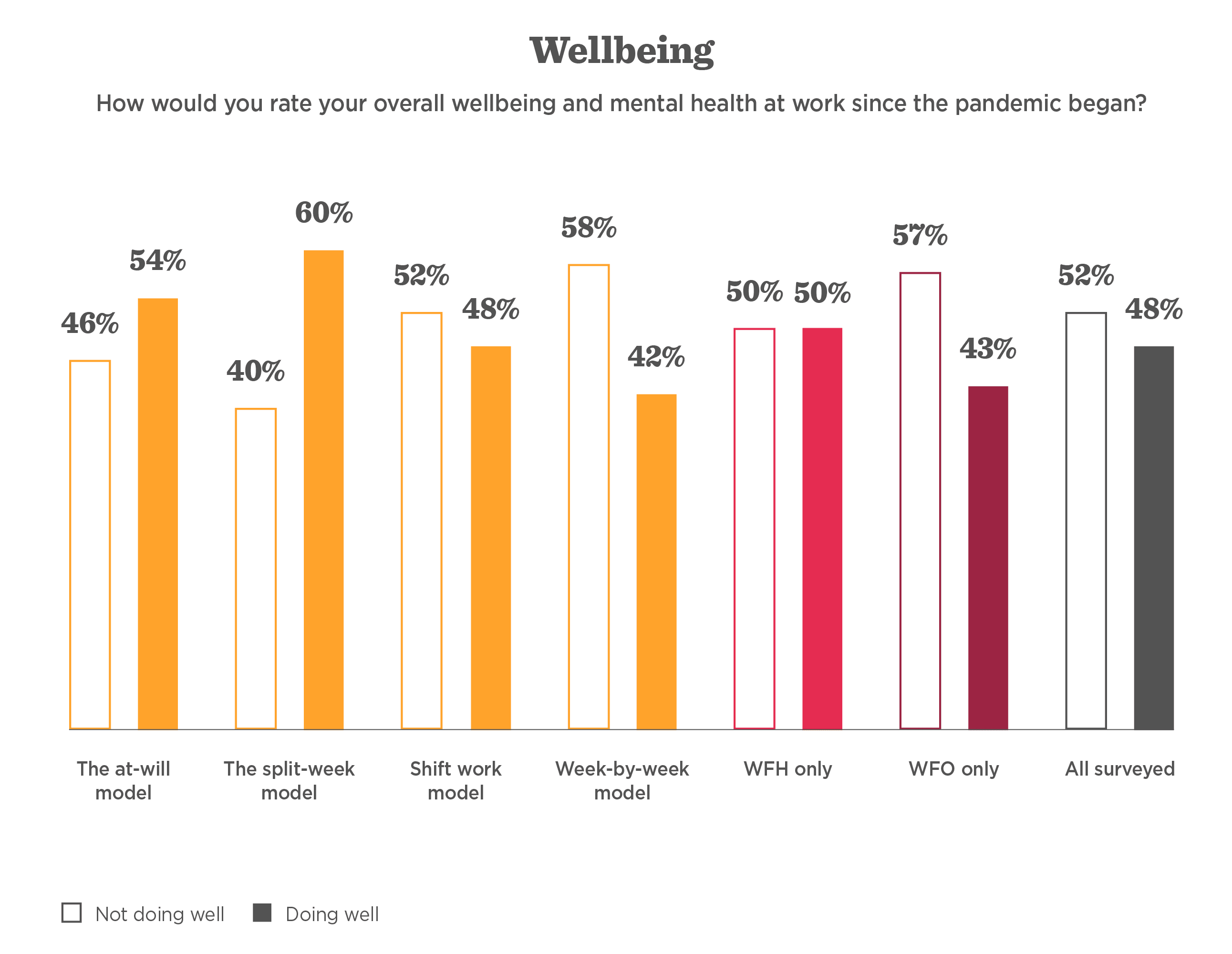
Expectations of HR teams regarding hybrid arrangements
Long after the end of the pandemic, HR still takes center stage. HR leaders have developed policies that support safe, productive workplaces and arrangements for WFH, hybrid, and on-site models.
According to our survey results, people working hybrid tend to feel that their HR teams adapt to their needs well, with 69 percent of those working at-will and week-by-week feeling supported by HR. Only 50 percent of those fully on-site reported feeling supported.
HiBob’s conclusion: People who are trusted to come to work based on their own judgment (at will) appreciate the flexibility it affords them to do their jobs well and to navigate through complex times.
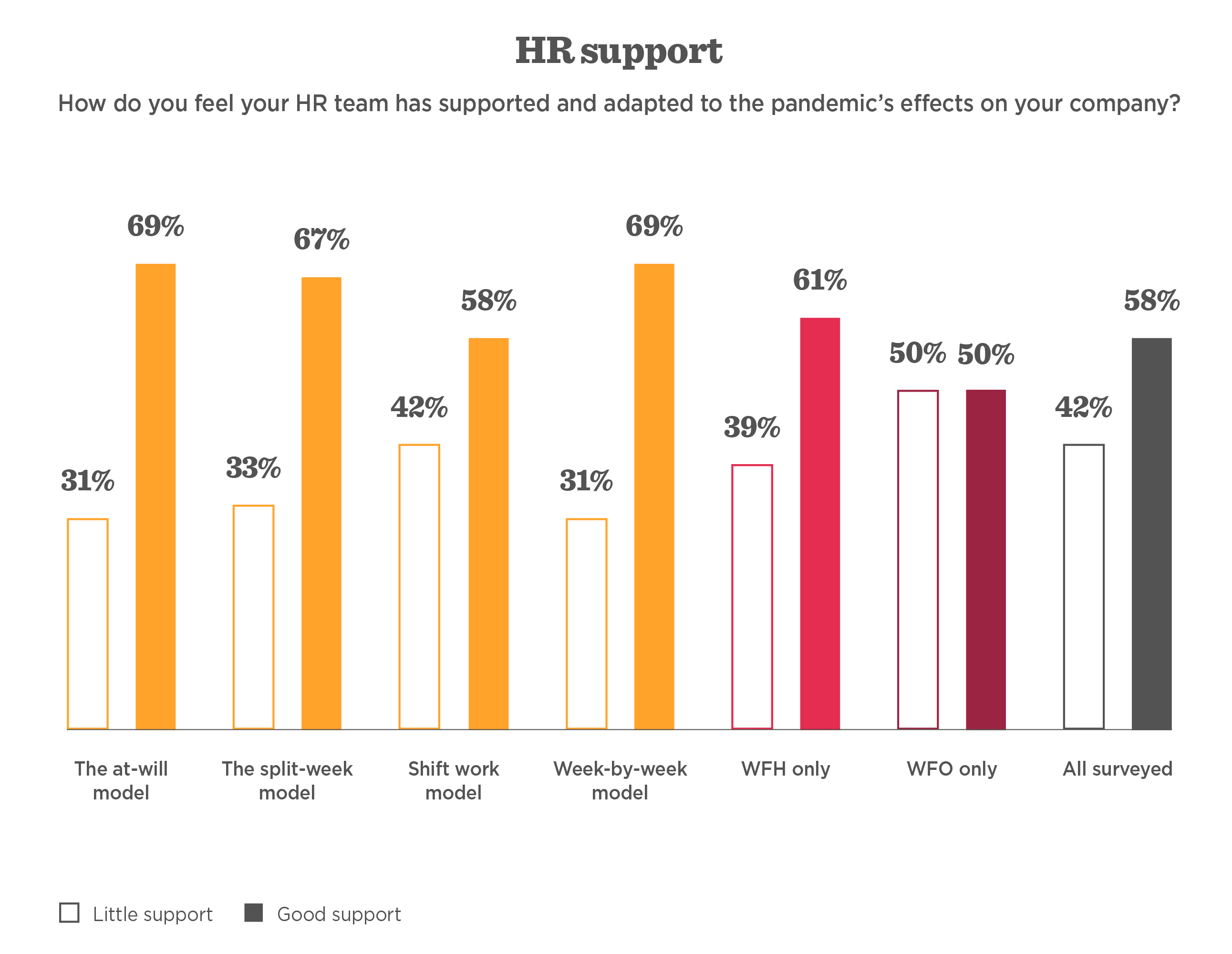
Similarly, hybrid workers were more confident overall when asked about HR’s ability to address remote work concerns. People who could come into the office at will showed the highest level of confidence in their HR teams. Those working on site exclusively felt the least confident toward their HR team.
HiBob’s conclusion: Team members working on-site full-time are less likely to trust their HR leadership because, regardless of the dangers inherent to working on site during a pandemic, they’re forced to work on site as usual.
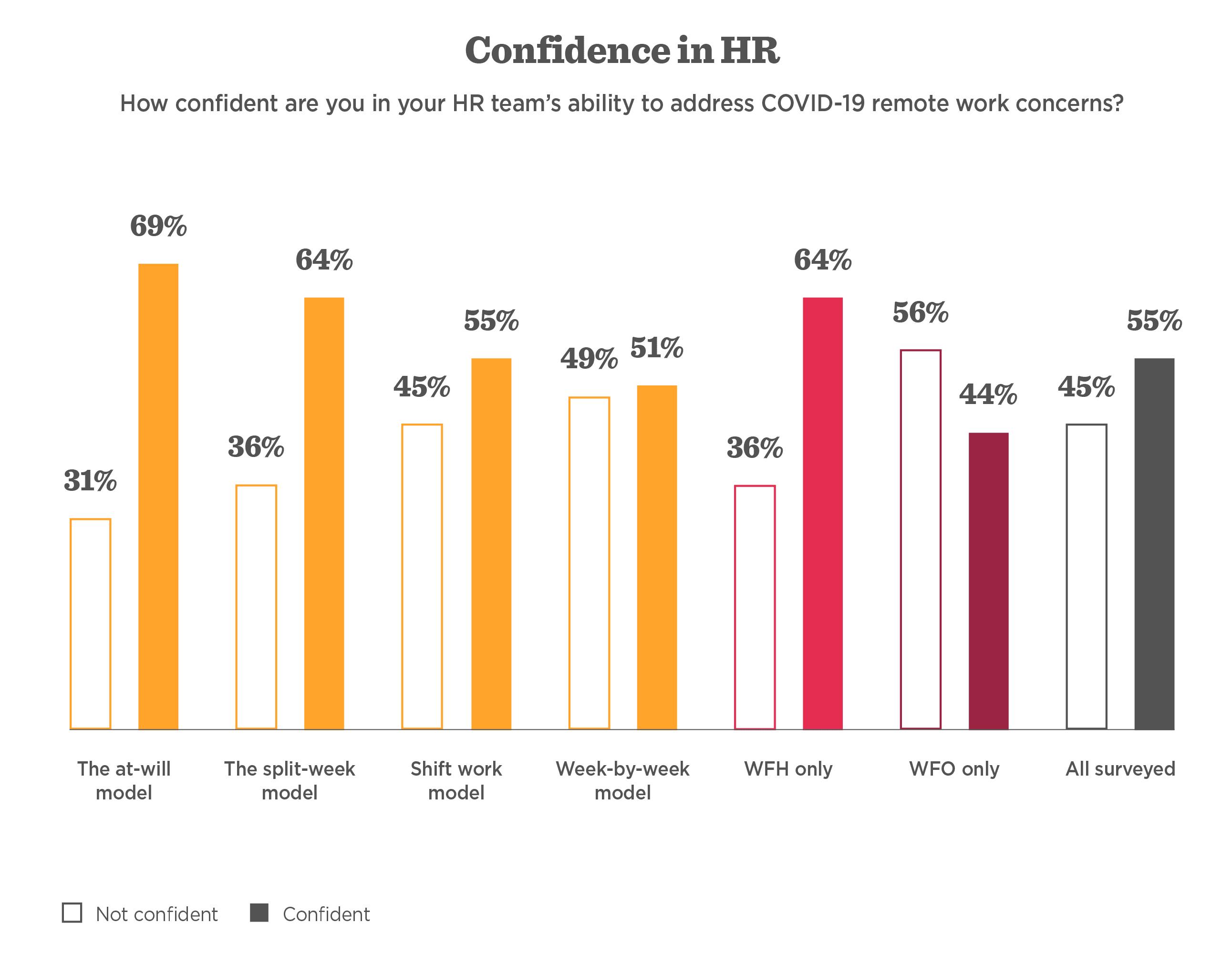
Additional advantages of hybrid work
While the HiBob study took place during COVID-19, the results still demonstrate the lasting impact hybrid work arrangements can have on people’s productivity, engagement, and wellbeing. Since then, we’ve learned more about hybrid work’s evolving benefits, revealing further insights into how flexible models impact team members.
Better physical health
Hybrid work arrangements help minimize the spread of contagious illnesses in the workplace. When team members feel under the weather but are still able to work, they can stay home and avoid exposing others—reducing the risk of office-wide outbreaks from seasonal colds, flu, or other common illnesses. As a result, companies with hybrid models often report fewer total sick days and a healthier workplace overall.
These models also support people managing non-contagious health issues. Team members dealing with allergies, migraines, or chronic pain can choose to work from home on high-symptom days, staying productive while prioritizing their well-being. This flexibility reduces absenteeism and allows people to work even when they’re not feeling 100%.
Wider talent pools
Hybrid work models remove geographic barriers, allowing companies to tap into a broader, more diverse talent pool. Without strict location requirements, organizations can recruit the best candidates based on skills and culture fit—not zip codes.
This flexibility also opens doors for people in different life stages and situations. Parents navigating school drop-offs, caregivers with daily responsibilities, and individuals with mobility challenges can all thrive in roles that don’t require a daily commute. Creating space for more people to contribute fully helps build more inclusive and resilient teams.
Decreased long-term costs
A striking 90 percent of CEOs report reduced business costs after adopting hybrid work policies. These savings come primarily from downsizing office space, lowering utility expenses, and reducing supply needs. The financial advantages extend to team members as well. Hybrid workers also save around $51 per day by reducing commute-related costs like gas, vehicle wear and tear, parking fees, professional wardrobe, and daily meals. These savings can add up to thousands of dollars annually without salary increases.
Hybrid work policies also support Corporate Social Responsibility (CSR) goals in cost-effective ways. Fewer commutes and smaller office footprints mean reduced emissions and environmental impact. Positioning hybrid work as part of your CSR strategy can help meet any sustainability targets without requiring major new investments.
Potential limitations of hybrid work model
Even the most effective workplace strategies, including hybrid work, come with challenges. While this model offers flexibility and autonomy, it can lead to communication gaps, inconsistent collaboration, or blurred boundaries between work and personal time. Understanding these potential limitations allows teams to proactively design workflows and support systems that maintain strong performance and morale across locations.
Remote team members may feel disconnected
Even in hybrid environments, it’s easy for people working remotely to feel a bit disconnected. Without hallway chats or spontaneous coffee breaks, staying connected takes a little more intention. HR teams can help by:
- Scheduling regular team video calls with both work and social components to help maintain relationships.
- Planning in-person team days focused on relationship-building rather than just work tasks to strengthen bonds
- Creating digital spaces for casual conversation that mimic the water cooler interactions that happen naturally in offices
Managers can alleviate this further by checking in with remote team members regularly about their general wellbeing and connection to the team.
Team members may face increased risk of burnout
Without clear boundaries between work and home life, hybrid team members might develop an “always on” mentality. This can lead to longer working hours, difficulty disconnecting, and eventually employee burnout.
HR leaders can address this by:
- Establishing clear expectations about working hours and availability
- Encouraging managers to model healthy boundaries by not sending emails outside working hours
- Creating policies on empathy in the workplace that respect personal time and make it clear that immediate responses aren’t expected after hours
- Implementing regular wellbeing check-ins to identify burnout before it becomes severe
- Training managers to recognize the signs of overwork in their teams
The company must invest in upfront implementation costs
Transitioning to hybrid work requires initial investment in policy development, technology, and potential office reconfiguration. These costs can feel high, especially for smaller organizations. HR leaders can approach this strategically by:
- Partnering with IT and Facilities early on to ensure the right infrastructure and support systems are in place
- Measure productivity, employee satisfaction, recruitment success, and retention rates before and after implementation to demonstrate value to leadership
- Reinvesting the savings from reduced real estate needs into better tools and training
Team members may lack tools for effective at-home work
Remote work can become frustrating and less productive without the proper equipment and technology. Team members struggling with slow home internet, uncomfortable setups, or outdated devices may not perform at their best.
HR leaders can overcome this by establishing minimum technology standards for remote work. This might include providing laptops, stipends for home office furniture, or reimbursement for internet upgrades. Training on digital security, communication tools, and managing potential distractions can also help team members make the most of their home environment.
Conduct regular surveys about remote work challenges to identify and address emerging needs—before they impact performance.
Hybrid work model best practices
Here are a few of the most important things to consider when planning your hybrid work model:
1. Solicit feedback before implementation
Speak to your people and find out what they think. Which type of hybrid arrangement would work best for them? Do teams across your business have different needs or preferences? It’s inevitable that some people will prefer flexibility, whereas others may wish to have fixed touchpoints to connect with their teams and to be able to plan around a more predictable schedule.
2. Establish clear policies and work expectations
Create transparent guidelines so everyone can plan their weeks effectively while keeping up with important tasks. Some people work better with complete flexibility and others need more structure. Tailor your policies to accommodate different working styles while maintaining team cohesion.
Develop clear policies that address:
- Required in-office days (if any) for different teams or roles
- Core working hours when all team members should be available
- Communication expectations for response times and preferred channels
- Meeting protocols for in-person gatherings
- Performance metrics that focus on output, not visibility
3. Invest in technology and remote work tools
Organizations use hybrid work best when they bring the office together with the virtual world. That means using digital tools that make communication and collaboration easy and keep people looped into conversations, wherever they might be working from.
A hybrid work model naturally makes it trickier to keep track of your workforce and day-to-day HR practices. Using a human resource information system (HRIS) can be a great way of maintaining contact and making sure your strategy is able to flex and evolve as needs change:
It can:
- Facilitate flexible benefits packages that give your people freedom to adjust their benefits to suit their needs
- Make it easy to schedule, track, and analyze information gathering at routine feedback meetings and via team- or company-wide surveys
- Provide managers with everything they need to monitor where their team members are each day, and to make sure progress is being made on key tasks
- Make managing vacation and training days far more straightforward, no matter how dispersed your teams may be
Beyond an HRIS, prioritize tools to create seamless employee experiences between home and office environments. For example, video conferencing platforms with integrated whiteboarding capabilities, cloud-based document sharing, and project management software that centralizes tasks and progress can keep operations running smoothly across different locations.
4. Expand your work community into the virtual sphere
Digital communication platforms have become common in the modern workplace. They facilitate more effective collaboration between hybrid team members and help protect and evolve company culture.
That means you shouldn’t solely rely on these tools for completing work tasks; instead, think about how you can ensure those working from home feel connected and part of your team. Encourage casual conversations and consider scheduled check-ins to make sure everyone feels engaged and happy at work.
5. Embrace asynchronous communication
Modern business tools are built specifically to support flexible work patterns. Encourage your people to share the information others need on specific threads, so that team members can then complete their tasks in their own time, and consider taking on project management software that enables easy tracking.
Status updates, questions, and information sharing can then happen asynchronously, enabling everyone to work without interruption or having to stay glued to video calls throughout the day. It will also help relieve your managers from micromanagement—freeing up their time and building greater trust with your people.
6. Protect opportunities for collaboration
“Water-cooler” chats are often said to be the backbone of productive work environments, with complicated questions, problems, and even negotiations sometimes more easily resolved in sidebar conversations than in official meetings. Opportunities to catch up with colleagues are also a key part of building a supportive culture and a sense of shared purpose, both of which contribute to a happier, more productive culture.
Protect these interactions by encouraging virtual private chats or by scheduling enough time for teams to connect in person.
7. Consider different needs and make space
It’s inevitable that people respond differently to hybrid work practices, so it’s important that you provide the support they might need. Reconfiguring your benefits systems to protect fairness, hosting virtual happy hours, and providing regular one-on-one meetings with managers are great ways of keeping everyone engaged and making sure you’re the first to hear of any issues.
8. Foster a culture of accountability and inclusivity
Encouraging open conversations about your hybrid work model as you develop it is key to empowering your people to engage with the way they work. Creating dialogue will give them space to discover their most productive work patterns and help them build connections with colleagues in the virtual sphere. In that way, your shared sense of company culture will expand, existing beyond the walls of the office.
Leading by example matters significantly. The manager relationship improves when they model the hybrid approach—working remotely sometimes and coming into the office for collaborative work—validating the effectiveness of the model for everyone.
9. Support employee wellbeing
Don’t assume that working from home automatically means a better work-life balance. Many remote workers actually work longer hours when working from home. The lack of physical separation between work and personal spaces can make it difficult for team members to disconnect, leading to increased stress and eventual burnout.
HR leaders can protect wellbeing in hybrid environments by scheduling regular, structured check-ins focused on how the individual feels, not just task completion. Train managers to look for digital signs of burnout, such as emails sent outside working hours, decreased engagement in virtual meetings, or changes in communication patterns
Consider creating virtual employee recognition channels where people can publicly acknowledge each other’s contributions. Schedule regular team celebrations that hybrid workers can join either virtually or in person.
Personal touches like handwritten notes or small gifts sent to home offices can make remote team members feel valued and seen despite physical distance.
10. Offer access to co-working spaces
Not every team member thrives working from home, and some miss the energy of a shared workspace—especially if they live far from your main office. HR can support these employees by offering access to co-working spaces closer to where they live.
Co-working spaces provide professional environments with fast internet, ergonomic setups, and a sense of structure—without the need for a long commute. Consider partnering with co-working networks that offer flexible, multi-location access so employees can choose the setup that works best for them on any given day.
11. Build in regular feedback loops
Hybrid success depends on listening to your people. Create regular opportunities for employees to share their experiences, such as pulse surveys focused on hybrid-specific themes like tech usability, team connection, manager support, and productivity.
Go a step further by analyzing feedback by team, location, and role to uncover trends and challenges. Most importantly, close the loop—share what you’ve learned, what actions you’re taking, and how you’ll keep improving. When employees see their input driving real change, they feel heard, valued, and more engaged in shaping the future of work.
Support work-life balance and maintain collaboration with a hybrid work model
There are many working models available, with relevance depending on the nature of your business. However, our research found that companies that offered their people hybrid work models are the most likely to enjoy success. These arrangements allow them to provide optimal work conditions for their people, expanding work culture beyond the office and making space for professionals to truly flourish and grow.
Companies need to adapt to their team’s strengths, but first and foremost, they need to listen to their people and ensure that their needs and wellbeing are taken care of, to ensure a safe, healthy, and productive future.
Hybrid work model FAQs
What are the biggest concerns for hybrid workers?
HR leaders implementing hybrid work models may face some of these common concerns:
- Isolation and disconnection: Team members working remotely can feel separated from workplace culture and informal interactions. Combat this by scheduling regular team connection days, creating virtual social spaces, and training managers to check in about wellbeing, not just tasks.
- Career visibility: People fear being overlooked for opportunities while working remotely. Address this by creating transparent promotion criteria based on measurable outputs, ensuring remote voices get priority in hybrid meetings, and designing mentorship programs that work regardless of location.
- Work-life boundaries: Many hybrid workers struggle to separate their professional and personal lives when working from home. Establish clear expectations about availability hours, create company-wide “offline times,” and encourage dedicated workspace setups that allow for physical transitions at the end of the workday.
The most effective hybrid workplaces directly acknowledge these challenges rather than pretending they don’t exist. When leadership openly addresses these concerns and models healthy hybrid work behaviors themselves, team members develop greater confidence in the arrangement and feel more comfortable adapting their own work styles.
How can leaders measure hybrid working model success?
Start by defining clear goals for your hybrid model— like improved productivity, cost reduction, talent attraction, or overall satisfaction. Establish baseline measurements before implementation to create meaningful comparisons later.
Collect feedback through brief, frequent pulse surveys about collaboration effectiveness, work-life balance, and manager support. Use HR platforms with analytics dashboards to track productivity, performance metrics, and communication flows.
Pay attention to both quantitative metrics and qualitative indicators like meeting engagement and team dynamics. Refine your approach based on what the data reveals rather than treating evaluation as a one-time assessment.
Is hybrid work the new normal?
While hybrid work has gained significant momentum, calling it “the new normal” oversimplifies a complex shift in workplace dynamics. Hybrid arrangements have grown across many industries, but their implementation varies widely.
It makes more sense for companies in financial services, marketing agencies, or software development to offer hybrid work because these jobs primarily involve computer-based tasks that can happen effectively from various locations. However, fields requiring physical presence—healthcare, manufacturing, retail, and hospitality— require different approaches.
Rather than following trends, create intentional workplace strategies for your unique circumstances. The true “new normal” isn’t any specific arrangement but rather increased thoughtfulness about how, when, and where work happens most effectively.
Recommended For Further Reading
Should managers choose to work a hybrid schedule?
This question sparks debate among HR leaders, with valid perspectives on both sides. Those advocating for managers maintaining full-time office presence argue that:
- Physical presence helps managers better coordinate between remote and in-office team members
- Being available for spontaneous in-person questions can speed up decision-making
- On-site managers can more easily monitor team dynamics and step in when issues arise
- Constant visibility reinforces leadership presence, especially in traditionally office-based companies
However, managers adopting hybrid schedules argue that:
- They need work-life balance too and benefit from the flexibility hybrid work provides
- Working remotely sometimes gives them firsthand experience with the challenges their hybrid team members face
- Modeling hybrid work at leadership levels demonstrates trust in the arrangement and removes stigma for team members
- Hybrid schedules allow them dedicated focus time for strategic work away from constant interruptions
What matters most isn’t where managers work but how they adapt their leadership style to support both remote and in-office team members effectively.
What makes hybrid work successful?
A successful hybrid work environment comes from strategic planning and intentional management. Implement these key elements to get the best results from your team:
- Clear communication protocols: Establish which channels to use for different types of communication, expected response times, and how to document decisions. This clarity prevents information gaps between in-office and remote team members.
- Results-based performance evaluation: Move away from “time in seat” metrics to measuring output and impact. Set clear deliverables and timelines regardless of where work happens.
- Equitable meeting practices: Design meetings that give equal voice to remote and in-person participants. This might mean having everyone join virtually even when some are in the office.
- Intentional collaboration planning: Schedule in-office days around activities that benefit most from face-to-face interaction. Save deep focus work for remote days to maximize the benefits of each environment.
- Technology investment: Provide proper tools for better collaboration regardless of location. This includes reliable video conferencing, digital whiteboarding, communication platforms, and cloud-based document sharing.
- Documentation habits: Develop habits of recording decisions, sharing updates, and making information accessible. This prevents knowledge silos and ensures everyone has equal access to important information.
- Leadership alignment: Ensure all levels of management support and model hybrid work practices. Inconsistent application creates confusion.
